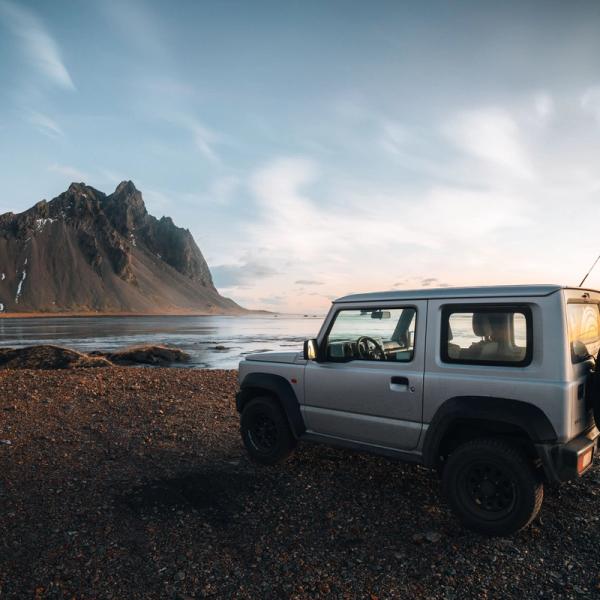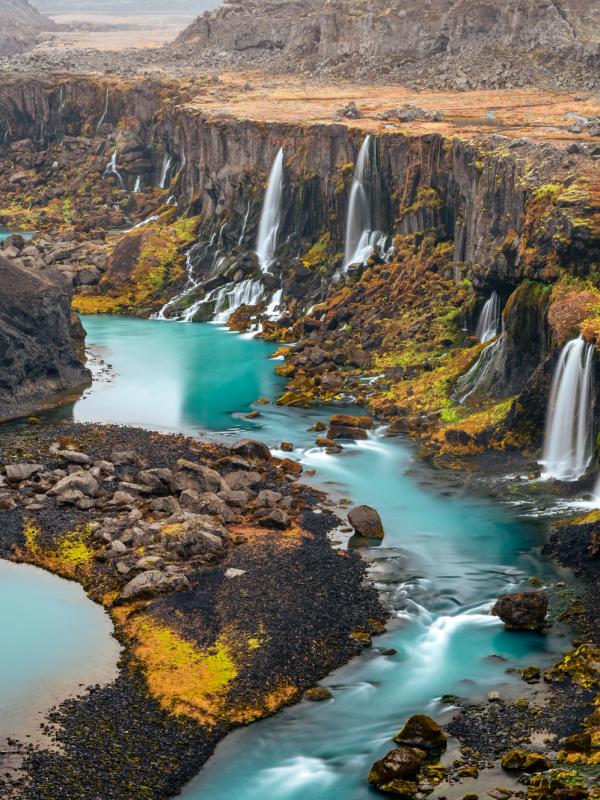
Sigöldugljúfur Canyon: Complete Guide to Iceland's "Valley of Tears"
Sigöldugljúfur Canyon is tucked away in Iceland's Central Highlands. You'll see tons of small waterfalls flowing down green cliffs into bright blue water. This canyon is called the "Valley of Tears" and it's pretty remote. The green moss against the black rock looks amazing, and there are clear springs that make it feel like you've found something special in the middle of nowhere.
Key Takeaways:
- You need a 4x4 to get here via F-roads (open June-September only)
- Has 50+ small waterfalls flowing down mossy cliffs
- Easy 1.2-mile walk, not too hard for most people
- No bathrooms or facilities – bring everything you need
- Works great with Landmannalaugar (23 km away) for a full day
- Best photos in early morning or late afternoon
What's Sigöldugljúfur Canyon?
Sigöldugljúfur Canyon is a 2-kilometer canyon carved into Iceland's volcanic landscape. Bright blue water flows through it with dozens of small waterfalls along the sides. The canyon sits about 500 meters above sea level in the Central Highlands, north of Fjallabak Nature Reserve.
The name "Sigöldugljúfur" means something like "valley of waterfalls," though locals call it "Valley of Tears" because of how the small waterfalls look like they're crying down the mossy eastern wall. Unlike many Icelandic canyons that feel harsh and dramatic, this one looks almost unreal thanks to the bright green moss that grows in the mist from the falls.
Here's what makes it special: You drive through dark, empty lava fields for an hour, then suddenly this bright green spot appears. The river runs clear through the bottom, fed by springs that keep the water bright blue. It's the kind of place that makes you stop and stare.
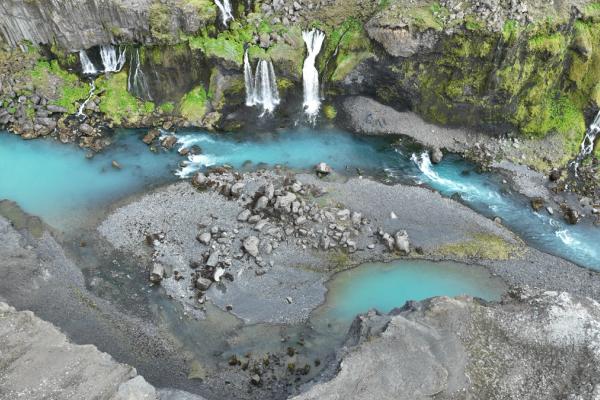
Why Should I Visit It Over Other Attractions in Iceland?
Iceland has waterfalls everywhere, but most come with crowds. Gullfoss gets packed, Seljalandsfoss has tour buses lined up, and Skógafoss in summer is crazy busy. Sigöldugljúfur gives you that "wow" factor without fighting for photo spots.
The canyon is unique: instead of one big waterfall, you get this wall of dozens of smaller ones. It's like nature made a giant water feature. The mossy cliffs stay bright green even in Iceland's short growing season because of the constant moisture.
Plus, getting there is part of the fun. You'll drive through highland landscapes that feel completely untouched. No gift shops, no parking fees, no crowds – just you and some of Iceland's wildest places. If you like discovering spots rather than checking them off a tourist list, this place works.
Key advantages compared to other natural spots:
- No entrance fees: completely free, unlike many popular attractions
- Small crowds: usually fewer than 50 people per day vs. thousands at Ring Road sites
- 167 km (104 miles) from Reykjavik: closer than many highland destinations
- Good starting point: perfect for highland exploration
- 23 km to Landmannalaugar: easy to combine with hot springs in one trip
- Unique experience: 50+ waterfalls in one spot, found nowhere else in Iceland
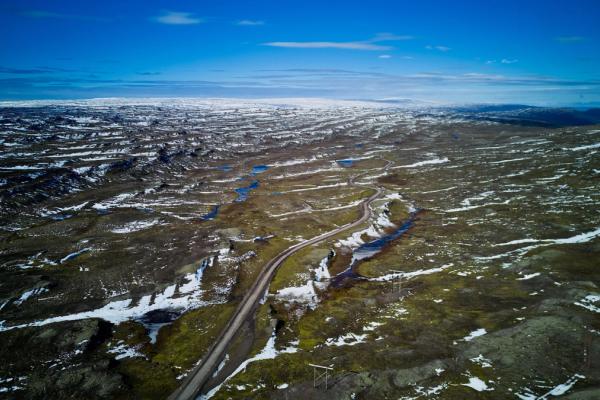
Location & How to Get There
Sigöldugljúfur Canyon sits in Iceland's Central Highlands, about 167 kilometers (104 miles) northeast of Reykjavik. Getting there requires driving on F-roads (mountain roads) that need a 4x4 vehicle and careful planning.
From Reykjavik (2.5-3 hours):
- Take the Ring Road (Route 1) east toward Selfoss for about 50 km
- Turn left onto Route 30 north toward Geysir/Gullfoss area
- Continue on Route 30, then turn right onto Route 32 heading north
- After about 40 km, connect to F26 (Sprengisandur route) heading north
- Drive north on F26 for about 20 km, then turn right (south) onto F208
- Follow F208 south for about 25 km past Sigalda Power Station
- Look for a small dirt road on your right with a yellow sign – this leads to the canyon parking area
The hardest part is spotting the turn-off to the canyon. There's no big sign, just a small yellow marker and a dirt track heading toward the canyon. If you reach Landmannalaugar, you've gone too far south on F208.
Vehicle Requirements: You need a 4x4 vehicle. F208 has sections of loose gravel, potholes, and stream crossings. The northern section (where you'll access Sigöldugljúfur) is generally easier than the southern F208 route, but don't try it in a regular car.
We offer vehicles suited for the Highlands, which must be 4x4 by law.
Alternative Access: If you don't want to drive F-roads yourself, several tour companies run Highland trips that include Sigöldugljúfur. These super-jeep tours usually combine the canyon with Landmannalaugar and run from Reykjavik as day trips (10-12 hours total). They cost around 150-200 USD per person but include transportation, a guide, and sometimes lunch.
Hiking the Canyon
The hiking at Sigöldugljúfur is pretty easy. It's more of a walk than a challenging hike. From the parking area, you'll walk about 1 kilometer (15-20 minutes) on a dusty dirt road to reach the main viewpoint.
Trail Details:
- Distance: 1.2 miles (2 km) round trip
- Elevation Gain: 127 feet (not much)
- Time: 30-60 minutes, depending on how long you spend looking around
- Difficulty: Easy. Fine for most people
The "trail" is actually an old access road, so the walking surface is fairly even. You'll cross some patches of uneven volcanic rock and maybe a small stream or two, but nothing technical. The path leads you across flat ground before dropping slightly to the canyon rim.
Once you reach the edge, you can walk along the rim in either direction for different views. There's no official trail along the rim, but you'll see worn paths where other people have walked. The classic photo spot is about 100 meters to your right (south) from where the access road meets the canyon edge.
What You'll See: The main thing is the eastern wall of the canyon, where dozens of small waterfalls flow down mossy cliffs. The falls range from tiny trickles to bigger streams, all feeding into the blue river below. The contrast between the bright green moss, black volcanic rock, and blue water creates that stunning effect you see in all the photos.
You can safely walk several hundred meters along the rim for different views, but stay well back from the edge. The canyon walls are steep and there are no railings or barriers.
Hiking Tips:
- Stick to already-worn paths to protect the fragile moss
- Don't try to climb down into the canyon – the walls are unstable and dangerous
- Bring a zoom lens or binoculars to get close-up views of the waterfalls
- Early morning or late afternoon give the best lighting for photos
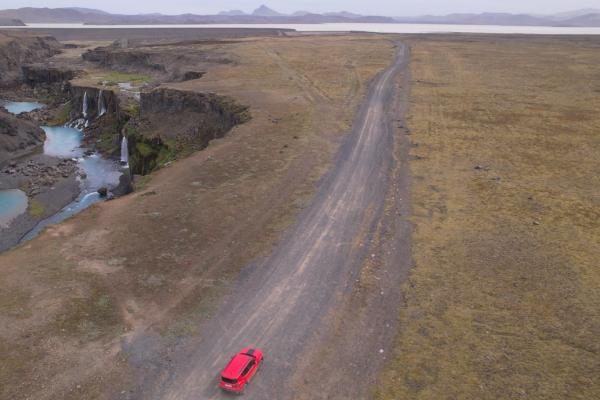
Other Things to See & Do There
While the waterfall viewpoint is the main thing, Sigöldugljúfur offers several ways to extend your visit and explore the area.
Photography and Looking Around
The canyon gives you tons of photo opportunities beyond the standard postcard shot. Walk along the rim to find shots that include the river winding through the canyon, distant highland views, or close-ups of individual waterfalls. The contrast between the green cliffs and the blue water looks beautiful in photos.
Best lighting happens during golden hours, roughly 2 hours after sunrise or 2 hours before sunset during the summer months. During Iceland's peak summer (late June), you'll have almost 24 hours of light thanks to the Midnight Sun, giving you plenty of time to try different angles.
Birdwatching and Wildlife
The canyon's unique climate attracts various bird species that you won't easily spot in the empty highlands. Arctic terns nest along the canyon walls and dive for fish in the river below. You might also see golden plovers, ducks, and geese that stop here during migration or breeding season.
Bring binoculars if you're interested in wildlife. The best time to view is early morning, when birds are most active, before any tour groups arrive. Sit quietly at the rim for 10-15 minutes and you'll likely spot several species.
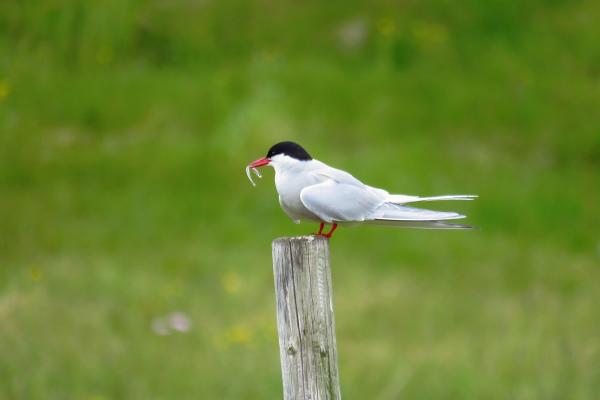
Longer Rim Walks
For more time here, you can follow informal paths along the canyon rim for up to a kilometer in either direction. Walking north along the rim gives you views of where the canyon curves toward the power plant. Walking south gives you distant views toward Landmannalaugar and the Highlands beyond.
These rim walks take you away from any crowds and give you real solitude in the Highlands. The ground is uneven volcanic rock and moss, so watch your steps, but it's not technically difficult.
Picnicking and Relaxing
The canyon rim makes a good spot for lunch, especially if you're combining your visit with other destinations in the Highlands. There are no facilities, so pack everything you need. The sound of the waterfalls gives natural white noise, and the views are way better than any restaurant view.
Practical Information for Visitors
Although is a pretty straightforward visit, a little bit of planning goes a long way.
Weather & Best Time to Visit
- Season: June through September only. F-roads close completely from October through May due to snow and ice.
- Best Months: July and August offer the most reliable access and warmest temperatures. June can work, but check road conditions carefully, as late snow sometimes delays F-road openings. September has fewer crowds and autumn colors, but days get shorter and the weather becomes more unpredictable.
- Daily Weather: The weather in the Highlands changes fast. Even in summer, temperatures rarely go above 15°C (60°F) and can drop to near freezing at night. Expect wind, and always prepare for rain regardless of what the morning forecast says. Fog can roll in suddenly, reducing visibility to almost zero.
- Best Time of Day: Early morning (7-9 AM) or late afternoon (6-8 PM) gives the best lighting and fewer visitors. Most tour groups arrive between 11 AM and 3 PM.

What to Wear & Bring
Sigöldugljúfur Canyon is very remote, so you must bring everything you need and be really prepared for any type of weather.
Essential Clothing:
- Waterproof jacket with hood (not just water-resistant)
- Warm layers – fleece or wool sweater
- Waterproof pants or rain pants
- Warm hat and gloves (even in summer)
- Sturdy hiking boots with ankle support
- Wool or synthetic socks (avoid cotton)
What to Pack:
- Plenty of water (no sources at the canyon)
- High-energy snacks or full lunch
- First aid kit with basic supplies
- Offline maps or GPS device (cell service is spotty)
- Extra phone battery or power bank
- Camera gear and extra memory cards
- Sunglasses and sunscreen (UV reflects off water and rock)
- Bug spray for summer visits
- Emergency blanket
Photography Gear:
- Tripod for long exposures of the waterfalls
- Polarizing filter to reduce glare on the water
- Wide-angle lens for canyon views
- Telephoto lens for waterfall details
- Lens cleaning cloth (spray from falls can mist your lens)

Safety Tips
The canyon edges have no barriers or railings, so staying well back from the rim is important. The volcanic soil can be unstable, especially after rain. Never try to climb down into the canyon the walls are steep, loose, and dangerous. Flash flooding can happen if water is released from the dam upstream, so watch for rapidly rising water levels.
Cell service doesn't work well throughout the Highlands, so don't count on being able to call for help. The nearest medical facility is over 2 hours away in Selfoss, so being prepared is key.
Critical Safety Information:
- Emergency distance: 150+ km to nearest hospital in Reykjavik
- Cell service: Spotty or nonexistent – download offline maps
- Road conditions: Check road.is before leaving – closures happen suddenly
- Vehicle requirement: 4x4 mandatory – rental insurance often excludes F-road damage
- Weather changes: Temperature can drop 15°C in 30 minutes
- Cliff danger: 20-30 meter drop with no barriers – stay 3+ meters from edges
- Flash flood risk: Dam releases can raise water levels 2+ meters in minutes
- Rescue time: 4-6 hours minimum for emergency helicopter response
Where to Stay Nearby
Places to stay near Sigöldugljúfur are limited because of its remote location, but there are some nice options. Here are your best choices for overnight stays:
Landmannalaugar Campground (23 km away)
The closest place to stay near the canyon. This basic campground offers tent sites, dorm beds in a mountain hut, and minimal facilities. You'll have access to the famous Landmannalaugar hot springs for bathing. Facilities include cold water, pit toilets, and a basic shelter, but no showers or electricity.
Camping costs about 3,200 ISK ($24) per person per night. Mountain hut beds must be reserved well in advance through Ferðafélag Íslands (Icelandic Touring Association) and cost around 15,800 ISK ($122) per night in shared dorms. It’s not cheap, but it’s a unique experience.
Highland Center Hrauneyjar (50 km away)
This is your closest option with real amenities. Located where the paved road ends and the F-roads begin, Highland Center Hrauneyjar offers hotel rooms, a restaurant, a fuel station, and basic supplies. It's expensive because of its isolation. Expect to pay 25,000-45,000 ISK ($180-$355) per night for a double room, but you'll get hot showers, heating, and a nice restaurant.
The center also serves as a hub for Highland tours and has staff who can keep you updated on current road conditions and weather.
Hólaskjól Highland Huts (40 km south on F208)
If you're continuing south on F208 toward Eldgjá or other southern highland destinations, these cabins offer a middle option. Basic but comfortable cabins cost around 11.500 ISK ($90) per night per person. The location is beautiful, sitting beside a river with mountain views, but the facilities are minimal.
Day Trip Options: Many people do Sigöldugljúfur as a long day trip from Reykjavik (3 hours each way) or from South Coast towns like Hella or Hvolsvöllur (1.5-2 hours each way). This avoids the limited and expensive highland places to stay but makes for a long driving day.
Towns along the south coast offer much better value places to stay, with guesthouses starting around 12,000 ISK ($85) per night for double rooms.

Places to Visit Nearby
Sigöldugljúfur's highland location puts you close to several other destinations that are perfect if you want to stay longer in the region.
Landmannalaugar (15 miles south)
This is the must-visit combo with Sigöldugljúfur. Landmannalaugar has colorful mountains, natural hot springs for bathing, and hiking trails.
The drive between them takes about 1 hour on the F208. Plan to spend 2-3 hours at Landmannalaugar for hiking and soaking at the hot springs.
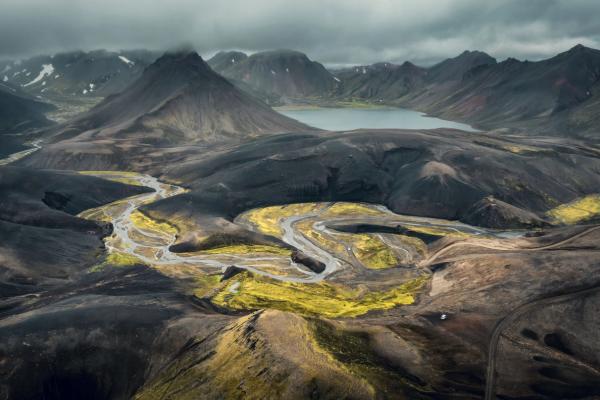
Háifoss Waterfall (28 miles southwest)
One of Iceland's tallest waterfalls, at 122 meters, Háifoss is a good addition to your Highland loop. The waterfall drops into a dramatic canyon, and nearby Granni makes for a great combo. You’ll have to drive about 4.3 miles on the rough F332, but it's doable with any 4x4.
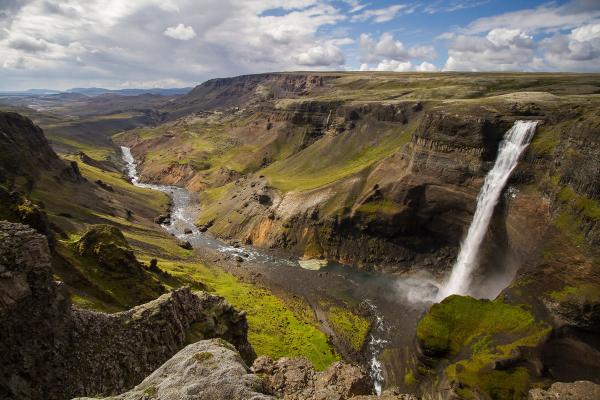
Sigöldufoss (2.5 miles away)
A smaller waterfall right along F208 near the power plant. It's worth a 10-minute stop on the way to or from Sigöldugljúfur. The falls are easily visible from the road and give a nice warm-up for the main canyon attraction.
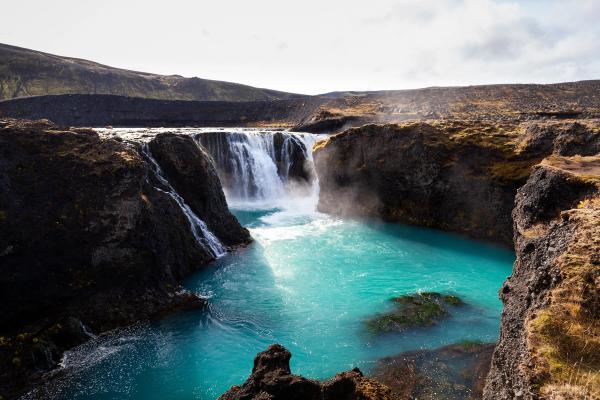
Bláhylur Crater Lake (9.3 miles north)
This bright blue crater lake sits in a dramatic volcanic setting and offers good hiking around the rim. The track to reach it is rougher than the main F208, but the lake's intense blue color gives another contrast to the highland landscape.
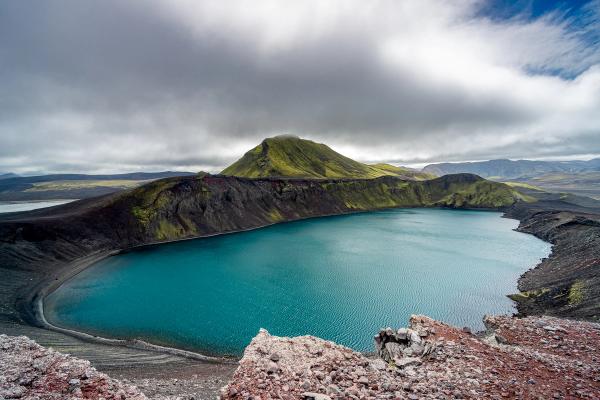
Eldgjá Canyon (37 miles south)
If you're planning multiple days in the highlands, Eldgjá offers a completely different type of canyon experience. This huge volcanic fissure runs for 40 km and includes the impressive Ófærufoss waterfall. To get there, you must continue south on F208 and deal with some river crossings, so it's only for experienced F-road drivers.
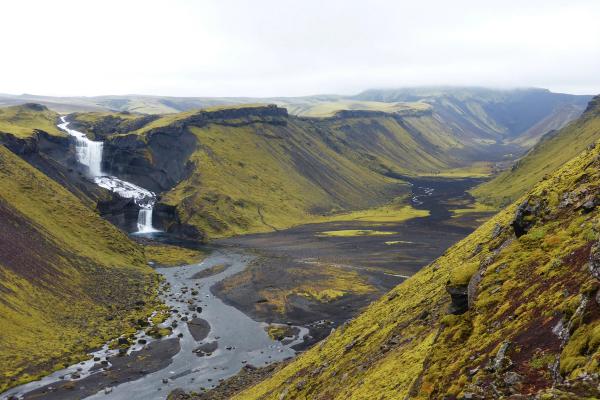
Formation & Geology
Sigöldugljúfur formed through natural forces and human changes that created something unexpected. Originally, glacial water carved this canyon through layers of volcanic rock over thousands of years. The bedrock is mainly palagonite (weathered volcanic tuff) and basalt, which explains the dark colors of the canyon walls.
The canyon's current look dates back to 1978 when the Sigalda Hydroelectric Power Station was built upstream. The dam created a reservoir called Krókslón, altering the river's water levels. Before the dam, the river ran much higher, and the canyon walls were partially underwater.
When water levels dropped after the dam was finished, it exposed the porous volcanic rock that now feeds those dozens of small waterfalls. These falls aren't fed directly by the river; they come from groundwater seeping through cracks in the rock. The constant water flow keeps the moss growing year-round, creating that bright green contrast against the black rock.
Geological Facts:
- Canyon depth: 20-30 meters deep
- Canyon length: about 2 kilometers
- Rock age: 10,000+ years old (post-glacial volcanic formations)
- Dam impact: Water levels dropped 20+ meters after 1978
- Waterfall count: 50+ individual waterfalls along the eastern wall
- Elevation: 500 meters above sea level
- Water temperature: 4-8°C year-round from groundwater springs
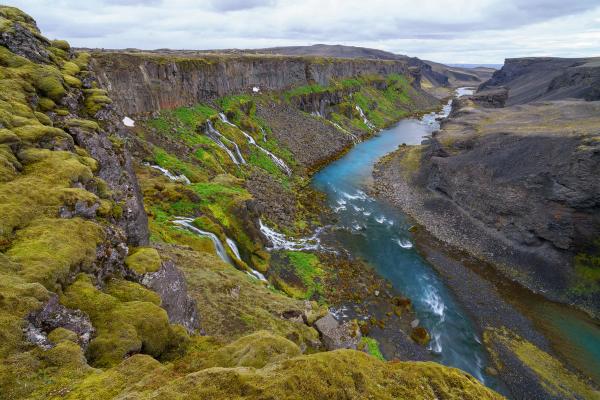
Conclusion
Sigöldugljúfur Canyon gives you that amazing Iceland experience without the crowds that come with more famous destinations. Those dozens of small waterfalls flowing down mossy cliffs create a scene that looks almost too good to be real, but it sits there waiting for anyone willing to drive a few hours on gravel roads.

